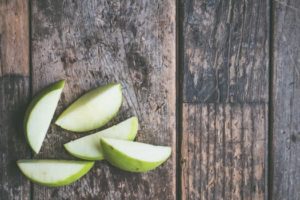Written by Jessica Patella, ND. A ten-year population study finds that white fruits and vegetables are inversely associated with the incidence of stroke.
 In the United States someone has a stroke every 40 seconds and someone dies of a stroke every 4 minutes, making it the 5th leading cause of death in the U.S. 1. Studies have shown that a high consumption of fruits and vegetables lowers the risk of stroke 2,3, but does it matter what type of fruit or vegetable? A 10-year population study found that white fruits and vegetables specifically were associated with a decreased risk of stroke 4.
In the United States someone has a stroke every 40 seconds and someone dies of a stroke every 4 minutes, making it the 5th leading cause of death in the U.S. 1. Studies have shown that a high consumption of fruits and vegetables lowers the risk of stroke 2,3, but does it matter what type of fruit or vegetable? A 10-year population study found that white fruits and vegetables specifically were associated with a decreased risk of stroke 4.
The 10-year population study was conducted in the Netherlands and included 20,069 men and women from 20-65 years of age (8,988 men, 11,081 women; average age 42 +/-11 years). Participants in the study completed a 178 food frequency questionnaire, as standardized and developed for Dutch people 5. Participants indicated whether they had consumed a particular food a certain number of times per day, week, month, year or never 4. It is important to note that potatoes and legumes were not considered vegetables since their nutritional value differs significantly from true vegetables 4,6.
Fruits and vegetables were then categorized into 4 color groups: green, yellow/orange, red/purple, and white. The following results were observed 4.
- Women consumed less alcohol and used dietary supplements more often than men
- Women had higher total fruit and vegetable consumption
- Men had higher intake of calories, whole grain foods and processed meat
- Participants averaged 378 +/- 198 grams/day of fruits and vegetables
- The largest consumption of fruits and vegetables were from the white category (36%)
- This comprised primarily of hard fruits (55%) such as apples and pears
- The orange/yellow category was the second most commonly consumed group (29%)
- This comprised primarily of citrus fruits (78%)
During the 10-year follow-up, 19 fatal and 226 non-fatal stokes occurred. Of the 19 fatal cases, 12 had a non-fatal stroke previously 4.
Higher consumption of white fruits and vegetables was inversely associated with the incidence of stroke (Q4, >171 g/d; HR 0.48; 95% CI 0.29-0.77) compared with those with a low consumption of fruits and vegetables (Q1 <78 g/d). There were no other statistically significant results with other fruit and vegetable color groups 4.
For every 25 gram/day increase in white fruit and vegetable consumption, there was a 9% lower risk of stroke (HR 0.91; 95% CI 0.85-0.97) 4.
In conclusion, a higher intake of white fruits and vegetables may protect against stroke 4. This was a large population study, but the validity of food frequency questionnaires is often still a concern for researchers 4. This was the first study to look at color of fruit and vegetable intake 4.
Source: Griep, Linda M. Oude, WM Monique Verschuren, Daan Kromhout, Marga C. Ocké, and Johanna M. Geleijnse. “Colors of fruit and vegetables and 10-year incidence of stroke.” Stroke 42, no. 11 (2011): 3190-3195.
© 2011 American Heart Association, Inc.
Posted March 6, 2018.
References:
- Prevention CfDCa. Stroke Facts. 2017; Stroke statistics and facts. Available at: https://www.cdc.gov/stroke/facts.htm. Accessed March 5, 2018, 2018.
- Dauchet L, Amouyel P, Dallongeville J. Fruit and vegetable consumption and risk of stroke a meta-analysis of cohort studies. Neurology. 2005;65(8):1193-1197.
- He FJ, Nowson CA, MacGregor GA. Fruit and vegetable consumption and stroke: meta-analysis of cohort studies. The Lancet. 2006;367(9507):320-326.
- Griep LMO, Verschuren WM, Kromhout D, Ocké MC, Geleijnse JM. Colors of fruit and vegetables and 10-year incidence of stroke. Stroke. 2011;42(11):3190-3195.
- Ocke MC, Bueno-de-Mesquita HB, Goddijn HE, et al. The Dutch EPIC food frequency questionnaire. I. Description of the questionnaire, and relative validity and reproducibility for food groups. International journal of epidemiology. 1997;26(suppl_1):S37.
- Environment NIfPHat. Dutch Food Composition Database. 2016; The Dutch Food Composition Database (NEVO) contains data on the composition of foods eaten frequently by a large part of the Dutch population. These foods contribute significantly to the intake of energy and nutrients. Foods of importance for specific groups of the Dutch population are also included. Available at: https://www.rivm.nl/en/Topics/D/Dutch_Food_Composition_Database. Accessed March 5, 2018, 2018.

